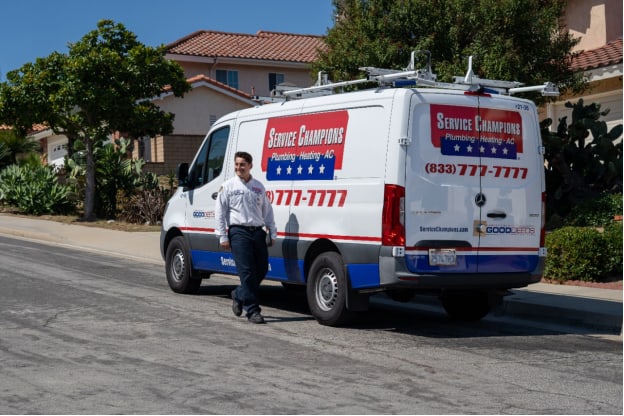An emergency plumbing repair rarely happens when itís convenient. Whether itís Christmas day, 3 am, or during a major storm, the only thing worse than...
An emergency plumbing repair rarely happens when itís convenient. Whether itís Christmas day, 3 am, or during a major storm, the only thing worse than a plumbing disaster is having to wait until you can get an appointment with a professional plumber.
Fortunately, some plumbing issues can be repaired at home with some DIY plumbing fixes. Check out these quick plumbing repair solutions for every homeowner.
Burst Pipes
A burst pipe is a scary and stressful situation. If you donít act quickly, you can end up with extensive water damage to your home and property. Even after you fix the plumbing itself, you could end up dealing with mold growth and structural problems†in the future.
If you have a burst pipe, follow these steps:
Turn off the water supply at the main water shut-off valve. Open all your faucets to drain the remaining water in the pipes and reduce pressure. Call a professional plumber like Service Champions to repair the pipe and assess any damage to the plumbing system.Leaking Faucets
Though less dramatic than a burst pipe, leaking faucets can be just as damaging. Having a leak wastes water and causes your utility bills to skyrocket, but fortunately, fixing a leaky faucet is a simple DIY job.
†Hereís what to do if you have a leaky faucet:
Turn off the water supply to the faucet using the local water shut-off or the main supply shut off. Disassemble the faucet by removing the faucet handle and cartridge or ball assembly. Replace washers or cartridge if they have wear or damage and replace them with new ones. Reassemble the faucet and turn the water supply back on.Clogged Drains
Clogged drains are among the most common plumbing problems a homeowner encounters. They can happen because of hair buildup, food debris, soap scum, grease, and foreign objects.
Instead of reaching for the drain cleaner, try these methods to unclog your drain:
Use a plunger. Create a seal around the drain and vigorously plunge up and down to dislodge the blockage and get the water moving. If that doesnít work, try a drain snake to reach the deep clog and remove it. Try a homemade drain clearing solution made of vinegar and baking soda. Mix equal parts and pour down the drain. The chemical reaction is often enough to remove clogs without harming your pipes.Avoid commercial drain cleaners†with harsh chemicals that can damage your plumbing and harm your health.
Overflowing Toilets

An overflowing toilet is a panic-inducing situation, especially if the water comes up over the sides and floods your bathroom. Itís important to stay calm and follow these steps:
Shut off the water supply, which is usually behind the base of the toilet. Use a plunger to try to dislodge the blockage. Create a strong seal and plunge consistently without breaking it. If the water drains, try flushing again to see if the toilet is working properly. Donít use drain cleaners for your toilet!Water Heater Problems
A malfunctioning water heater is a big nuisance in your home. You probably use hot water multiple times a day for showering, cooking, cleaning, and more, so your life is often disrupted by a broken water heater.

The most common cause of†water heater problems†is sediment build up. If you experience water heater issues, hereís what to do to drain the water heater:
Turn off the water heater. Drain the water by running hot water in your sinks for a few minutes. Shut off the water supply lever at the top of the appliances. Grab a hose and attach it to the spigot near the bottom of your water heater, then snake it out the window or down a drain. Release the water supply lever and watch as your buildup flows out. Once the water is clear, turn off the lever and remove the hose.If that doesnít work, try to determine the cause of the problem. Here are some things to check:
Check the pilot light to see if itís lit. if not, follow the instructions from the manufacturer to relight it. Check the circuit breaker (electric water heaters) to ensure it hasnít tripped. Inspect your water heater for leaks. Look at the water heater itself and the area around it, which should reveal pooling water or drips.Water heaters can be complex and dangerous to work on, especially if you donít have plumbing experience. If you canít correct the problem with these simple tips, be sure to call a pro to get it done safely and correctly.
Low Water Pressure
Low water pressure can be frustrating and may indicate an underlying plumbing issue. Hereís what to do if youíre experiencing a sudden drop in water pressure:
Check your other faucets to see if itís just one fixture or all of them. Clean the faucet aerators to remove mineral deposits that can affect water flow. If all else fails, call a plumber. You could have a major plumbing issue deep in your system or a slow leak somewhere in your home.Constantly Running Toilet
A toilet that runs constantly is annoying, but it can also cost you a lot of money. Sometimes, the running toilet doesnít even make noise, so you donít realize thereís a problem until you get your water bill.
A running toilet is often caused by the flap at the bottom or a buildup of calcium. Push down on the flapper with a stick to see if the water stops running. If it does, you know the flapper isnít sealing properly and needs to be replaced. Hereís how:
Turn off the water supply to the toilet. Flush the toilet to drain out most of the water. Unhook the chain at the flushing handle and remove the old flap. Get a replacement flap of the same type and install it following the instructions. Hook the flapper chain onto the flush lever arm and leave a little slack.If the flap isnít the issue, check the fill valve for a leak:
Flush the toilet and look for a fill valve leak. Lift up on the toilet float arm when the tank is filling to see if the water stops. Bend or adjust the toilet float arm so the tank stops filling when the water level is one half to one inch below the top of the overflow pipe. If the fill valve still leaks, it needs to be replaced.Dos and Doníts of At-Home Plumbing
Your plumbing system is one of the most important parts of your home. You can tackle some plumbing repairs on your own, but itís important to know when to stop and call a professional. Here are some dos and doníts for your DIY plumbing.

Plumbing Repair Dos
Do make sure you have the right tools.Basic plumbing can be challenging, and you need to be prepared if something goes wrong. Do turn off the water supply before you start.Whether youíre fixing a toilet or a faucet, the first step is always turning off the water supply. Otherwise, you could end up with a bigger mess than you bargained for. Do use natural drain cleaners.Clogs are tough to deal with, but donít be tempted to use a harsh commercial drain cleaner. Instead, use home solutions like vinegar and baking soda or hot water.Plumbing Repair Doníts
Donít put trash in your garbage disposal.Itís easy to think of your garbage disposal as a way to dispose of all your food scraps, but thatís not what itís designed to do. Youíre only supposed to put small food debris in your garbage disposal, so avoid items like fats, cooking oils, coffee grounds, cornhusks, vegetable skins Donít overdo it with plumbing connections.Yes, your plumbing connections need to be tight, but donít overtighten them. You should only tighten them as much as you can with your hand. Otherwise, you could end up with cracked pipes or porcelain, broken bolts, and stripped screws. Donít push forward if youíre running into problems.If youíre in over your head, the worst thing you can do is keep going. You could end up with much bigger Ė and more expensive Ė problems, not to mention that it can be dangerous. Donít hesitate to ask for help.Plumbing is a big job. If you feel overwhelmed with your DIY plumbing repair, contact the pros at Service Champions for expert help.Contact the Pros at Service Champions for Your Plumbing Repairs

Itís easy to forget your plumbing system exists when itís running properly. But when itís not, few things are as stressful or disruptive. Some minor plumbing issues can be handled at home, such as small clogs or a constantly running toilet. If you try to tackle your own plumbing repairs and find yourself in over your head, however, Service Champions is here for you.†Contact us†today to schedule your appointment.












